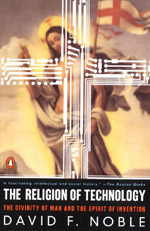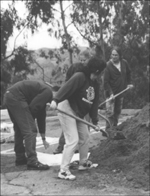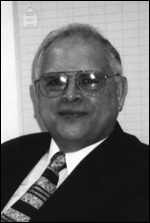 (Reprinted with permission from the Boston Globe, written by George Scialabba)
(Reprinted with permission from the Boston Globe, written by George Scialabba)
In 1896, the scholar and diplomat Andrew Dickson White, cofounder and first president of Cornell University, published two hefty tomes titled, in typically orotund nineteenth-century fashion, A History of the Warfare of Science with Theology in Christendom. One hundred years later, another distinguished scholar, David F. Noble (author of the acclaimed study America by Design) has published a book that might well have been titled “A History of the Harmony of Religion with Technology in Christendom.” Which story is true?
The two stories are not, it turns out, incompatible. White’s is the familiar David-and-Goliath drama of intellectual freedom vs. ecclesiastical authority; the Inquisition, the Index of Forbidden Books, and other agents of darkness are hauled on stage and hissed, while new victims—scientists, literary men, and other doughty champions of the light—are carried off on the shoulders of the cheering crowd. All highly agreeable to the secular liberal reader and, as far as it goes, perfectly accurate.
Noble’s story, The Religion of Technology, is less well known. For the last ten centuries or so in the West, he writes, technological visionaries have consistently spoken the language of Christian millenarianism. They have described themselves, and genuinely seen themselves, not in Promethean or Faustian terms, as encroaching divine prerogative, but rather as fulfilling a divine plan. It is true that St. Augustine, the most influential of the early church fathers, was very eloquent about the weaknesses of the flesh and the wretchedness of life here below; and Christians have always been painfully, sometimes obsessively, conscious of original sin. But other Christians—including, it seems, many of the leading scientists of Western history—have been just as keenly conscious of the promised Second Coming. These medieval and modern believers share “an enduring, otherworldly quest for transcendence and salvation”—Noble’s “religion of technology.”
We are prone nowadays to label almost anything a religion: Marxism, monetarism, Freudianism, vegetarianism, attitudes toward the Internet. Noble disavows such casual analogies. His title “is not meant in a merely metaphorical sense to suggest that technology is similar to religion in that it evokes religious emotions of omnipotence, devotion, and awe, or that it has become a new (secular) religion in and of itself, with its own clerical caste, arcane rituals, and articles of faith. Rather, it is meant, literally and historically, to indicate that modern technology and religion have evolved together and that, as a result, the technological enterprise has been and remains suffused with religious belief.”
During the early Middle Ages, Noble’s story goes, the theological significance of the “useful arts” changed. Once no more than a distraction from the things of the spirit or, at best, a solace for fallen mankind, they began to be seen as a means to our recovery of Adam’s lost perfection and a sign of humanity’s imminent entry into a glorious New Order. Why this change occurred is uncertain; perhaps because the invention of the horse collar and the iron plow transformed daily life north of the Alps.
It was the Benedictine monasteries above all that were affected. A “veritable medieval industrial revolution” took place there, featuring windmills, watermills, clocks, eyeglasses, springwheels, metal forges, ore crushers, and other devices. Medieval writers like John Scotus Erigena and Hugh of St. Victor announced that the end, or telos, of the mechanical arts was to “restore within us the divine likeness.”
“Restoration” is the key to understanding this new theological current. From its inception, Christianity has been fiercely eschatological; the first disciples expected Jesus to return immediately and reestablish the Kingdom of God on earth. This expectation has been alive, even if sometimes submerged, in the Christian imagination ever since, along with the almost equally potent myth of Adam’s (i.e., humanity’s) original perfection, which the Second Coming is to restore.
As Noble demonstrates, the millenarian hope has taken a remarkable variety of forms. In the writings of Joachim of Flora, a twelfth-century monastic reformer and apocalyptic prophet; of Roger Bacon, the thirteenth-century Oxford philosopher; of the Italian Renaissance humanists; of Francis Bacon, Galileo, Kepler, Boyle, Newton, and a great many others—including the Rosicrucians, the Freemasons, and even the Puritans—the aim of science and technology is seen as “the restoration of mankind’s primal knowledge, shared with God at the beginning, but lost in the Fall.” Even in the high noon of nineteenth-century positivism, this theme sounds repeatedly.
According to Noble, the National Aeronautics and Space Administration, Los Alamos, the Human Genome Project, and the artificial intelligence community are honeycombed with apocalyptic Christians harboring “unspoken otherworldly aspirations.” Cyberspace, writes an AI researcher, is “a Heavenly City, the New Jerusalem of the Book of Revelation.”
There’s much fascinating intellectual and social history in The Religion of Technology, though Noble sometimes strains to fit it all into his grand pattern. There is a political point as well. The techno-spiritual visionaries were not, by and large, democrats. They were (are) a priesthood, supplied and supervised by their temporal masters. This is why technology has always fallen far short of its benign potential. The schemes of the techno-seers have so often failed to meet basic human needs because “at bottom, they have never been about meeting them. They have been aimed rather at the loftier goal of transcending such menial concerns altogether.”
They have also, of course, been aimed at producing pelf for the plutocrats and firepower for the state. Profits, power, and fantasies of transcendence—for a millennium or more this unholy trinity had held science and technology in thrall. Perhaps the next millennium will see an amicable parting.
Appetizer
They Only Seem Different
With the approach of the new millennium, we are witness to two seemingly incompatible enthusiasms, on the one hand a widespread infatuation with technological advance and a confidence in the ultimate triumph of reason, on the other a resurgence of fundamentalist faith akin to religious revival. The coincidence of these two developments appears strange, however, merely because we mistakenly suppose them to be opposite and opposing historical tendencies.


























